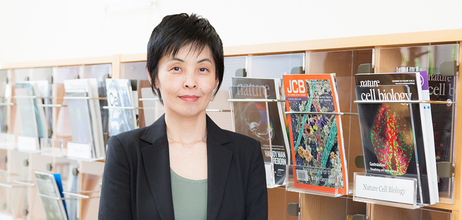Unit Leader

Biomolecular functions highlighted by leading-edge light microscopy technologies
* Due to the reorganization starting as new centers in April 2018, this laboratory is now belong to the Center for Biosystems Dynamics Research. As for the latest information, please see the following URL below.
> The webpage of Laboratory for Molecular and Cellular Dynamics, Center for Biosystems Dynamics Research

Unit Leader
Yuko Mimori-Kiyosue
2-2-3 Minatojima-minamimachi, Chuo-ku, Kobe, Hyogo 650-0047, Japan
Tel: +81-78-306-3224
![]()
We aim to elucidate the functions of biomolecules supporting vital activities and thereby contribute to extend the human health span. Activities of every single cell that forms the living body are supported by intracellular infrastructure. We particularly focus on the molecular mechanisms that control the cellular infrastructure “microtubules” responsible for intracellular trafficking, and analyze their function using cell models and mouse models, while making full use of the common-use Light Microscopy Facility that our laboratory run.
Appropriate organization of the microtubule cytoskeleton is required for intracellular transport and chromosome segregation. Its fine-tuning is critical for normal cell motility, morphogenesis and cell division, while the abnormal control is the cause of the disease [2-10]. We study how the activities of microtubule regulating molecules (Fig.1) support normal development or disease through phenotypic analysis of mouse and in vitro cell biology, to better understand the mechanisms of life and at the same time contribute to medical science.
The Lattice Light Sheet Microscope developed by Dr. Betzig laboratory (Howard Hughes Medical Institute) is a breakthrough technology overcoming the limitation of conventional fluorescent microscopy, which achieves whole cell 3D scan within one second at high spatiotemporal resolution [1]. Using this system, we have succeeded in capturing 3D dynamics of microtubule growth and chromosome movement in unprecedented accuracy (Fig.2). We are advancing efforts toward constructing this microscope in our lab to realize highly accurate 3D analysis of cellular events including cell division.
We run common-use Riken Kobe LIGHT MICROSCOPY FACILITY (kLMF), which offers about twenty light microscope system products and image analysis software.

CLST was reorganized into three centers according to the RIKEN 4th Medium-Term Plan from April 1, 2018. For the latest information of Cellular Dynamics Analysis Unit, please visit the following websites.
> The webpage of Laboratory for Molecular and Cellular Dynamics, Center for Biosystems Dynamics Research [http://www.bdr.riken.jp/en/research/labs/kiyosue-y/index.html]
> If you continue to browse this site, click here.